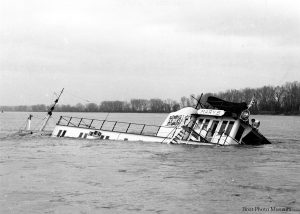The St. Louis Shipbuilding & Steel Company began in 1933 as a partnership involving Herman Pott, Everett Enslin and R.C. Bradshaw. The shipyard was on the site of the Rohan Boat, Boiler and Tank Company at St. Louis, which was also the location where James B. Eads built ironclad gunboats during the Civil War. Initially, the new firm constructed small towboats and barges, and in 1936 the company built its first significant vessel, the 300 hp. Senator Combs (see WJ, October 10, 2022) for Ashland Oil & Refining.
Two years later, in 1938, the company built the modern, “streamlined and air-conditioned” 800 hp. J.H. Duffy (WJ, August 7, 2023), a very futuristic looking towboat constructed while some steam sternwheel boats were still being built. In 1939, St. Louis turned out the all-steel 1,200 hp. St. Louis Socony, which was more traditional, with squarish cabins as well as the 800 hp. Alice M. Tyler, which appeared somewhat regressive after the Duffy since it had a wooden superstructure and a very boxy appearance.
It was announced in 1939 that St. Louis had secured a contract to build three towboats for Lake Tankers Corporation, a new firm to the river system. Two would be twin-screw conventional boats, and one would be single screw and equipped with a retractable pilothouse. The boats would be utilized to tow gasoline from the Shell Oil refinery at Wood River, Ill., to the Minneapolis-St. Paul area. This was a very significant contract for the 7-year-old firm.
The launch of the first of the Lake Tankers boats was covered in the April 20, 1940, issue of The Waterways Journal. The story stated, “The Twin Cities, new $250,000 Diesel towboat launched at 10:10 a.m. April 15 by the St. Louis Shipbuilding and Steel Company.” It went on to say that the boat had been christened by Mrs. Edward R. Brooks, daughter of Frank C. Wright, “RFC railroad specialist and head of the Lake Tankers Corporation.” Some 600 people attended the ceremonies.
After a series of trials, the Twin Cities was turned over to the owners for the initial trip. The boat had a steel hull that was 140 by 34 feet and drew 5.5 feet. It was powered by a pair of Fairbanks-Morse six-cylinder Model 37 direct-reversing engines with 1,180 total hp. at 300 rpm. The four-blade propellers were 84 inches in diameter. It was claimed that this was the first towboat with a “sound-proof engine room.”
The superstructure was of steel construction, with a full cabin on the main deck and an upper cabin that extended nearly the full length of the one under it. A large pilothouse was situated atop and forward on the upper cabin, and two smokestacks were behind that. The boat was painted white with a wide dark green trim from the handrails to the deck on each level. The stacks were white with a green band around the tops and the letters “LTC” situated in stairstep fashion on each outboard side.
The Twin Cities was often in the pages of the WJ afterwards, appearing in ads for Fairbanks-Morse as well as being mentioned in the news columns as having as many as eight 195-foot by 35-foot barges of oil in tow. According to the listings in the Inland River Record through the years, the engines were upgraded or “supercharged” to provide a total of 1,380 hp. Kort nozzles were placed at St. Louis Ship in 1947, a magnetic compass autopilot was installed aboard in 1948, and St. Louis Ship-patented Contra-guide rudders were placed on it in 1949.
Lake Tankers sold the Twin Cities in June 1954. The new owner was first listed as Houston-based B&M Towing Company. The boat was renamed Mary B and completely rebuilt by Nashville Bridge Company, Nashville, Tenn. where it was repowered with F-M OP 10-cylinder engines totaling 3,200 hp. at 720 rpm. Falk 2.5:1 reduction gears were installed as well. This project included the addition of bulwarks on the main deck and two new “Nashville-style” stacks placed just behind the pilothouse.

In 1956, the Mary B was shown as being owned by Texmar Inc., Houston and still operated by B&M. The List of Merchant Vessels continued to show the boat as owned by Texmar, but the 1960 edition of the Inland River Record lists it as being owned by “Boat 3202, Inc., Houston” and still operated by B&M. The 1961 IRR was again showing it as owned by Texmar but now operated by Rebel Towing Company, Houston.
On April 20, 1961, the Mary B, sporting the Rebel Towing Confederate flag logo on the stacks, was downbound on the Missouri River when the mixed tow of three loads and two empties grounded near Mile 151. The tow topped, causing the boat to be stranded broadside to the current. According to “Soundings,” a history of Missouri River navigation by John Ferrel, as the sand washed from under the upper side of the boat, it listed over until water came over the guard, sinking the vessel.
The wreck could not be raised immediately and became filled with sand. In October 1961, a dredge dug hole deep enough for the sunken boat to slide into. That, then, was the end of the Mary B (WB 4007, DED). However, as related by the late Dan Owen, long-time editor of the IRR, Rebel Towing soon acquired a new Dravo 3200 class towboat that the company named Mary B. Therein, of course, lies another story for another day.



